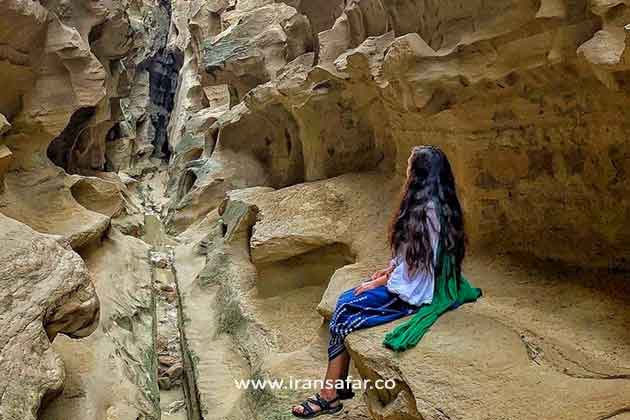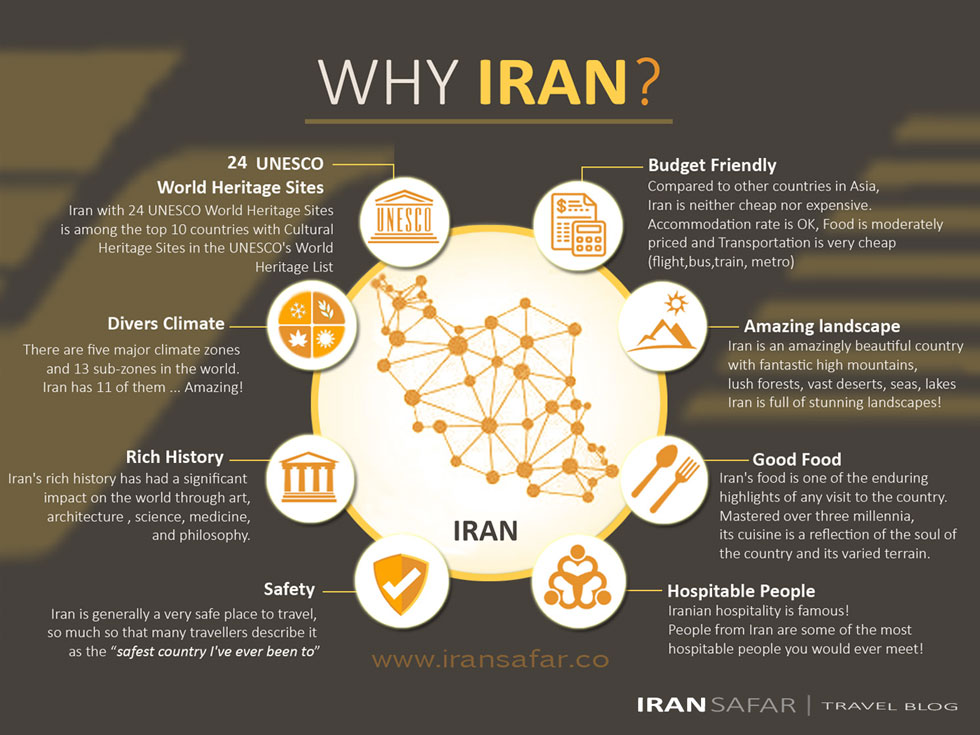Welcome to the land of culture and history – Iran. This captivating nation, often misunderstood, is a treasure trove of experiences waiting to be discovered. In this article, we will talk about 10 reasons why you should visit Iran. From its diverse climate to its sumptuous Persian cuisine, Iran is a hidden gem that offers an unparalleled travel experience.
1
Diverse Climate: A four season country
Iran boasts a remarkable diversity of climates, making it a year-round destination for travelers. From the Caspian Sea‘s mild, Mediterranean-like climate to the snowy Alborz mountain range, and the arid deserts of the Dasht-e Kavir and Dasht-e Lut, you can find your preferred climate, no matter the season.
In essence, Iran enjoys a harmonious coexistence of all four seasons. This country stands as one of the rare gems on our planet, boasting the beauty of distinct seasons, each offering a unique and captivating experience. Venturing into Iran throughout the year means embarking on a journey through diverse landscapes and a tapestry of adventures.
In the summer, you may find the weather cooling in the northern reaches, while warmth and scorching heat embrace other parts of Iran. Winter, on the other hand, blankets vast expanses with glistening snow, while the southern and southeastern regions bask in the embrace of hot and humid breezes.
North Iran reveals a lush canvas of evergreen Caspian Hyrcanian Forests , stretching alongside the Caspian Sea, where a mild climate invites travelers to explore its beauties. To the South, the Persian Gulf creates a sultry ambiance, with majestic palm fields that soothe the soul and ignite the imagination. Traveling East leads you through arid deserts and mesmerizing landscapes painted with a myriad of colorful sands, all under a sky that sparkles with a symphony of stars. Meanwhile, the West unfolds a dramatic panorama, where towering Zagros mountains punctuate the horizon.
2
UNESCO Sites: Iran’s Treasure
For history and culture enthusiasts, Iran is a goldmine. It’s home to 27 UNESCO World Heritage Sites, each narrating a unique chapter of human history. From the magnificent Persepolis to the stunning Jame Mosque of Isfahan, you’ll be awe-inspired by the ancient wonders that await.
Iran takes pride in its remarkable collection of 27 UNESCO-registered cultural sites, each with a unique story to tell. These sites encompass grand palaces, bustling bazaars, mosques and temples, ancient water systems, and the remnants of the illustrious Persian Empire. The country’s tourist attractions and historical landmarks are a testament to its rich heritage. Here are just a few notable examples:
Top UNESCO Sites of Iran
Persepolis: Locally known as Takht-e Jamshid, Persepolis served as the ceremonial capital of the Achaemenid Empire, a legacy constructed by the visionary leaders Cyrus the Great, Darius I, and King Xerxes. What endures of this pinnacle of Persian civilization are colossal columns and the remains of opulent palaces. The site is adorned with countless reliefs portraying royal figures, soldiers, nobles ad people from diverse backgrounds who once graced its halls.
Bam and its Cultural Landscape (Arg-e Bam): A glance at Bam conjures an image of a life-sized sandcastle. At the heart of it lies the iconic Arg-e Bam, a monument that has withstood the test of time for over 2,000 years, dating back to the Parthian Empire.
Shahr-e Sukhteh (Burnt City): Known as the Burnt City, this archaeological site unravels the mysteries of a sizable Bronze Age urban settlement associated with the Jiroft civilization. The reasons behind its abrupt rise and fall remain shrouded in enigma.
Tepe (Hill) Sialk Ziggurat: Situated in a suburb of Kashan, Isfahan Province, this substantial archaeological site has a storied history dating back to 5500–6000 BC. Joint research by Iran’s Cultural Heritage Organization, the Louvre, and the Institut Francais de Recherche en Iran has unveiled the oldest settlements at Sialk, adding to its historical significance.
3
Persian Cuisine
Persian cuisine is a tantalizing blend of flavors and aromas. Don’t miss out on tasting succulent kebabs, aromatic saffron-infused rice, and an array of delectable stews. The experience of dining in traditional Iranian restaurants is a treat for all your senses.
There are over 400 different kinds of food and sweets in Iran. The ingredients are generally cereals, grains, vegetables and proteins. The existence of various ethnic groups in Iran, alongside its rich culture, has made Iranian Cuisine highly diversified. Some of the most popular Iranian foods include, Aab Gousht (also Dizi), Fesenjan (Pomegranate Walnut Stew), Khoresht-e Bademjan (Eggplant and Tomato Stew), Baghala Polo (Rice with Dill and Fava Beans plus chicken or lamb), Zereshk Polo (Rice with Barberry plus chicken), Ghorme Sabzi (vegetable stew), Ash-e Reshteh (a thick soup with noodle, beans and vegetables) nuts and dried fruit), and Kebab (Barbecued Lamb, Chicken, Lamb Liver, Ground Meat).
Read More: Persian Cuisine
4
Hospitable People
One of the most endearing aspects of Iran is its people. Iranians are renowned for their warmth and hospitality. You’ll find yourself welcomed with open arms, invited to share tea and conversation, and even offered assistance in your travels. This genuine friendliness will leave a lasting impression on your journey.
5
Rich History: 7000 Years of Civilization
Iran’s history is a tapestry of civilizations, from the ancient Persians to the Islamic Caliphates. The country is strewn with historical landmarks, museums, and relics that chronicle the passage of time. Immerse yourself in the narratives of empires and dynasties that once thrived in this land.
Iran boasts a rich history that spans an astonishing 7000 years, making it one of the world’s oldest continuous civilizations. The Iranian Plateau, especially the southwestern and western regions, played a pivotal role in the Ancient Near East, giving rise to the Elamite Civilization during the Early Bronze Age. Over the centuries, it became a melting pot of various cultures, including the Kassites, Mannaeans, and Gutians. Notably, the renowned philosopher Hegel once hailed the Persians as the very first “Historical People.”
6
Budget-Friendly Destination
Traveling in Iran is a cost-effective endeavor. Despite its rich cultural offerings, the country remains relatively budget-friendly for tourists. Accommodations, food, and transportation are all reasonably priced, allowing you to experience the best of Iran without breaking the bank.
7
Amazing Landscape: An Ecotourism Heaven
From the lush greenery of the northern regions to the vast deserts and towering mountains, Iran’s landscape is diverse and captivating. Trekking through the pristine beauty of the Alamut Valley or gazing upon the surreal natural wonders of Qeshm Island will leave you awestruck.
Iran’s natural wonders encompass a wealth of mountains, lakes, caves, forests, unique plant and animal species, mineral springs, and a multitude of islands dotting its northern and southern coastlines. This abundant array of attractions has firmly established Iran as a favored destination for travelers seeking the beauty of unspoiled nature.
The allure of Iran’s ecotourism extends to iconic destinations such as the Golestan National Park in Gorgan, the expansive Dasht-e Kavir, the adrenaline-pumping Iran Ski Resorts, thrilling climbing ventures, exhilarating rafting expeditions, canyoning opportunities, mesmerizing treks through diverse terrains, and unforgettable Iran desert tours.
Wildlife of Iran is equally exceptional, featuring rare species such as the Asiatic Cheetah , the Siberian Kingfisher, Persian Fallow Deer, the Asiatic Black Bear, the Persian Gazelle, and Persian Onager. Notably, the magnificent blue whale graces the waters of the Persian Gulf, the largest marine habitat in the country.
Read More: Iran’s Natural Attractions
8
Architectural Marvels
Iran’s architecture is nothing short of mesmerizing. The intricate tile work of mosques and palaces, the grandeur of historic bridges, and the stunning gardens of Persia are a testament to the country’s artistic and architectural prowess. Every corner of Iran tells a story through its magnificent buildings.
9
Bazaars and Handicrafts: Timeless Artistic Heritage
Exploring the best bazaars of Iran is an adventure in itself. These markets are a kaleidoscope of colors, sounds, and scents. Here, you can purchase exquisite Persian carpets, intricate handicrafts, and delicate artwork.
Iran’s cultural legacy spans a breathtaking 7000-year history, showcasing rich arts and crafts. Iranian art & Handicrafts stand as of the most culturally significant and diverse in world history. This artistic tradition encompasses a wide array of subfields, each contributing to the country’s remarkable heritage. Here’s a glimpse of some of the most prominent:
Ghalamkar: Is a form of textile printing, yielding intricate and vibrant patterns.
Gereh-chini: This art, seen in the Nasir al-Mulk Mosque, involves assembling wooden frames and glass panels in mostly geometrical designs, creating stunning visual effects.
Silverwork: Iranian artisans have long excelled in the creation of various objects from silver, including trays, candlesticks, fruit dishes, cups, and other decorative items.
Engraving (Ghalamzani): This practice is both a science and an art, encompassing a broad range of applications, from personal hobbies to industrial and trade uses.
Inlaid Work (Khatam): A distinctive Iranian form of marquetry, Khatam, decorates wooden or metallic articles with meticulously cut pieces of wood, bone, and metal in various shapes and designs.
Miniature Art: Miniature paintings, whether created as book illustrations or standalone artworks meant for albums, are a celebrated Iranian tradition, showcasing remarkable detail and precision.
Tiling, Stone Carving, Brickwork, Stucco, and Tile Panels: Iran’s mastery of these crafts is evident in the intricate and breathtaking designs that grace architectural marvels and decorative elements.
Also Read: Miniature Art: Iran’s Intangible Cultural Heritage
10
Safety in Iran: A Journey Beyond Stereotypes
If you’re wondering what it’s like to visit Iran, don’t rely solely on politics or media. The best insights come from people who’ve been there, and you can find their experiences on travel forums. Iran is a captivating place with a rich history, vibrant culture, and friendly people. While safety is always a priority when traveling, Iran offers a memorable experience for those who are well-prepared and informed.
Don’t be swayed by extreme opinions on the internet. Some say there are no issues at all, while others paint a negative picture. The truth lies somewhere in between.
Iran faces tough sanctions due to global politics, which leads to negative media coverage. Remember, these disputes are between governments, not the people. One of the best things about Iran is the hospitality of its people. Despite what you may have heard, Iranians are incredibly welcoming to guests. So, when thinking about visiting Iran, keep an open mind and embrace the genuine beauty of the country, beyond the politics and headlines. It’s a unique journey where you can discover history, culture, and the warmth of its people.
Iran is a safe country in general, with a very low crime rate.
Read: Is Iran Safe to Travel in 2023?




Comment (0)